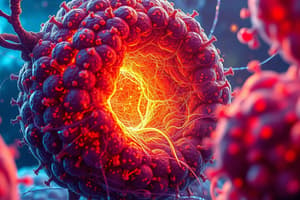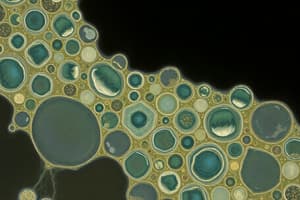Podcast
Questions and Answers
What is the primary function of a cell?
What is the primary function of a cell?
- Perform all functions of life independently (correct)
- Store genetic information only
- Facilitate communication between organs
- Serve as the structural component of tissues
Who explained the formation of new cells?
Who explained the formation of new cells?
- Theodore Schwann
- Matthias Schleiden
- Rudolf Virchow (correct)
- Robert Hooke
What allows a compound microscope to achieve greater magnification than a simple microscope?
What allows a compound microscope to achieve greater magnification than a simple microscope?
- Use of digital sensors
- Larger glass size
- Increased number of lenses (correct)
- Use of colored filters
What type of microscope is necessary to view the interior of a cell?
What type of microscope is necessary to view the interior of a cell?
What is the smallest size of a cell that can be observed?
What is the smallest size of a cell that can be observed?
Which of the following cells is the largest?
Which of the following cells is the largest?
What concept was modified to form the Modern Cell Theory?
What concept was modified to form the Modern Cell Theory?
What is the main difference between magnification and resolution?
What is the main difference between magnification and resolution?
What microscope is capable of magnifying images 1000 times or more?
What microscope is capable of magnifying images 1000 times or more?
Who is credited with the discovery that new cells arise from pre-existing cells?
Who is credited with the discovery that new cells arise from pre-existing cells?
Which cell is considered the smallest among all living organisms?
Which cell is considered the smallest among all living organisms?
Which of the following is NOT a postulate of cell theory?
Which of the following is NOT a postulate of cell theory?
What does the term 'totipotent' refer to in cell biology?
What does the term 'totipotent' refer to in cell biology?
The function of a light microscope is fundamentally based on what principle?
The function of a light microscope is fundamentally based on what principle?
Which type of cell is considered totipotent and has significant medical applications?
Which type of cell is considered totipotent and has significant medical applications?
What kind of microscope would be best to observe the interior of a cell?
What kind of microscope would be best to observe the interior of a cell?
What is the largest known cell in terms of size?
What is the largest known cell in terms of size?
Which scientist is associated with the examination of plant parts leading to the cell theory?
Which scientist is associated with the examination of plant parts leading to the cell theory?
What defines a totipotent cell?
What defines a totipotent cell?
Who proposed the cell theory stating that both animals and plants are made up of cells?
Who proposed the cell theory stating that both animals and plants are made up of cells?
What is the primary component of the cell wall in Gram-positive bacteria?
What is the primary component of the cell wall in Gram-positive bacteria?
Which statement is NOT a postulate of modern cell theory?
Which statement is NOT a postulate of modern cell theory?
Which type of cells exhibit a high degree of organization?
Which type of cells exhibit a high degree of organization?
What role do pili serve in bacteria?
What role do pili serve in bacteria?
Which of the following structures in prokaryotic cells aids in nutrient absorption?
Which of the following structures in prokaryotic cells aids in nutrient absorption?
In which subunit are bacterial ribosomes classified?
In which subunit are bacterial ribosomes classified?
What is the function of chromatophores in certain bacteria?
What is the function of chromatophores in certain bacteria?
Which of the following is NOT a primary function of the cell membrane in prokaryotic cells?
Which of the following is NOT a primary function of the cell membrane in prokaryotic cells?
Flashcards are hidden until you start studying
Study Notes
Cell Basics
- Cells are the structural and functional units of all living organisms and capable of independent existence.
- Microscopes are essential to observe cells, with simple microscopes magnifying up to 100 times and compound microscopes over 1000 times.
- Electron microscopes offer a much higher magnification, up to 500,000 times, allowing visualization of cell interiors.
Cell Shapes and Sizes
- Cells exhibit diverse shapes: spherical, rectangular, polygonal, and more; there is no typical shape.
- Cell sizes also vary, with some microscopic and others, like ostrich eggs, reaching up to 15 cm.
- Mycoplasma represents the smallest known cells (0.3 µm), while bacterial cells range from 3 to 5 µm.
Historical Context
- Cell theory, proposed by Matthias Schleiden and Theodor Schwann, states that all living organisms are composed of cells.
- Rudolf Virchow added to this theory in 1855, explaining that new cells arise from pre-existing cells (Omnis cellula-e-cellula).
- Modern Cell Theory incorporates advancements in cytology with updated postulates about cell functions and organization.
Totipotency
- Totipotent cells can differentiate into any cell type and have the potential to form an entire organism.
- Embryonic animal cells, or stem cells, are examples of totipotent cells with significant medical applications.
Prokaryotic vs. Eukaryotic Cells
- Living organisms are classified as prokaryotes (simple structure) or eukaryotes (complex structure).
- Prokaryotic cells possess a chemically complex protective envelope composed of three layers: glycocalyx, cell wall, and plasma membrane.
Bacterial Cell Structure
- Bacteria utilize a structure called glycocalyx, which can be a slime layer or a capsule, for protection and adhesion.
- Gram staining, developed by Hans Christian Gram, differentiates bacteria into Gram-positive and Gram-negative based on cell wall composition.
- Bacterial cells contain ribosomes (70S), which are crucial for protein synthesis, and harbor DNA in a region called the nucleoid.
Essential Components of Prokaryotic Cells
- The cell envelope consists of a tough glycocalyx layer, a peptidoglycan cell wall (in Gram-positive cells), and a phospholipid bilayer plasma membrane.
- Motile bacteria may possess cilia or flagella for movement, while other structures like pili and fimbriae help in communication and attachment.
- Internal structures include ribosomes, plasmids, chromosomal DNA, and cytoplasmic granules for nutrient storage.
Summary of Cell Theory Postulates
- All living organisms are composed of cells, either unicellular or multicellular.
- A cell is the basic unit of life and carries out all life processes.
- Cellular activities contribute to the overall functions of the organism, emphasizing the importance of individual cells within larger systems.
Microscopy
- Advanced microscopy techniques, including the application of different lenses, improve magnification and resolution of observed specimens.
- Plane and concave mirrors along with diaphragms are utilized in laboratory settings to enhance visibility and image clarity when examining cells.
Studying That Suits You
Use AI to generate personalized quizzes and flashcards to suit your learning preferences.




